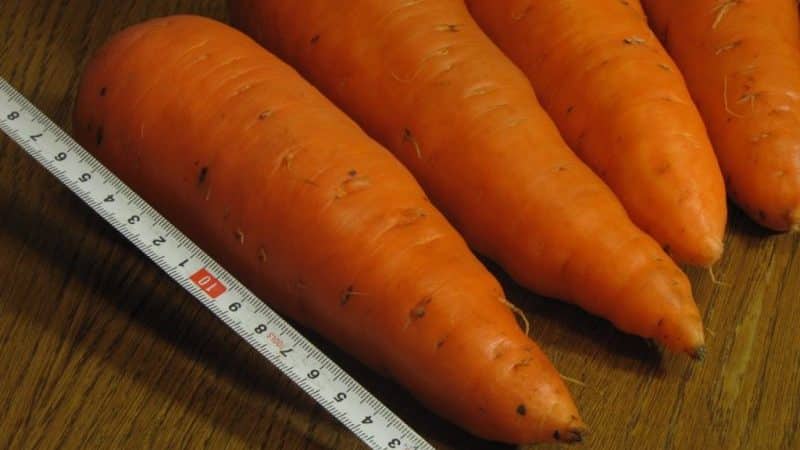Juicy and sweet carrot hybrid Abaco F1 with high yield
The Dutch carrot hybrid Abaco F1 is used for cultivation both in private plots and in large farms. Bright, juicy fruits have an excellent presentation, are easy to grow and do not crack.
From the article you will learn the features of hybrid agricultural technology, rules of plant care and methods of disease prevention.
Description of carrot hybrid Abaco F1
The Abaco F1 carrot hybrid was bred in Holland by Monsanto Holland B.V., a company specializing in the production and sale of agricultural plant seeds. In 2009, the hybrid was included in the Russian State Register.

Carrot roots are rich in the main substance in this vegetable - carotene, which contains about 19%. The fruit is juicy - per 100 g up to 12.4% dry matter. Sugar in vegetables – up to 8.4%.
Root vegetables contain a large amount of vitamins C, PP, E, a group of vitamins B, as well as H and K, which bring invaluable benefits to the human body: support immunity, participate in metabolic processes, affect the beauty of skin and hair, help in the functioning of the nervous system, etc.
Depending on climatic conditions, the ripening period of carrots ranges from 90-110 days from the first shoots to harvest. From one square meter you can harvest from 4 to 11 kg of crop or 430-550 centners per hectare, this is more than other popular varieties.
Important. Carrot variety Abaco F1 is considered one of the most disease-resistant crops, especially altenaria leaf spot.
The main features and characteristics of the hybrid include:
- weight - from 100 to 250 g;
- Fruit length is about 20 cm, thickness up to 6 cm;
- shape – cone-shaped with a blunt end;
- color – bright dark orange outside and inside;
- leaf shoots are dark green, lush, semi-spreading, up to 60 cm long);
- taste – sweet;
- juiciness – high;
- resistance – to bolting, cracking, diseases
- germination rate is high (up to 95%, better compared to other varieties and hybrids).
Abaco is frost-resistant, withstands temperatures down to -4°C. Recommended for cultivation in the North-Western, Central, Volga-Vyatka, North Caucasus, Middle Volga, Lower Volga, West Siberian and East Siberian districts.
The main advantages and disadvantages of a hybrid
Advantages of a hybrid:
- frost resistance;
- resistance to cracking and discoloration;
- excellent seed germination;
- high productivity;
- early ripening;
- correct shape and bright colors;
- juicy and not rough core (recommended for baby and diet food);
- Suitable for both manual and mechanical cleaning.
There is only one drawback - the high price of seeds.
Features of planting and growing
We bring to your attention detailed instructions for growing a hybrid - everything that is most important from preparing the soil to storing the crop.

Soil preparation
Growing carrots of the Abaco F1 variety begins with choosing a site for the bed. Choose sunny places for planting. For this hybrid, the best soil will be sandy-clayey with a loose structure.
Beds for sowing carrots, on which tomatoes, cucumbers, cabbage, onions or potatoes grew, will be excellent predecessors. But celery, zucchini and parsley are not the best predecessors.
The beds are prepared in the fall; for this, when digging, add half a bucket of compost or humus and one and a half cups of ash per square meter to the soil. m. Slaked lime or dolomite flour is added to acidic soils.
Sowing seeds
Planting of seeds is carried out in the spring in April-May, depending on climatic conditions, the main thing is that the ground warms up to at least +7°C.
To obtain an earlier harvest, seeds are sown in the fall just before the frosts or in the February windows. They are buried dry in the ground to a depth of 2-3 cm, maintaining a distance between rows of 20 cm. The surface is lightly compacted. In the spring, so that the soil warms up faster, the beds are covered with film.
In early spring, seeds are sown without pre-treatment, sown in moist soil to a depth of 1 cm and a distance between rows of 20 cm. Before emergence, they can be covered with film or agrofibre.
At a later planting, when the ground warms up to +16°C (early-mid June), the seeds can be soaked in growth stimulants and even germinate. Sow in the same way. The beds are watered abundantly until shoots appear. Late-planted fruits are good for long-term storage.
Caring for carrots
Further care for carrots consists of watering, thinning, loosening and weed control.
Plantings are watered in the evening, usually once a week or more often, depending on the weather. The hybrid does not tolerate high humidity, so it is watered moderately. Two weeks before harvest, watering is stopped.
After the shoots emerge, the carrots are thinned out, leaving 3 cm between plants in the row. Thin out a second time at the tops bunching stage, maintaining a distance of 8 cm.Leave the stronger plants and do not spare the weak and undersized ones, this way you make room for the full ripening of root crops.
Attention. Abaco carrot plantings are hilled and weeded several times a season.
Top dressing
Feed the plants ash and mineral fertilizers. Before the formation of root crops, in order for the plant to become strong, it is fertilized with nitrogen and phosphorus compounds, and then, to form a high-quality root crop, with phosphorus-potassium preparations or microelements. A month before harvest, fertilizing is stopped.
Disease and pest control
Abaco F1 carrots are a disease-resistant hybrid, but when conditions are favorable for the fungus, they sometimes become infected with powdery mildew. Watering and spraying with solutions such as “Baikal-M” and “Immunocytophyte” will help cope with the disease. For powdery mildew, preventive spraying is carried out with a solution consisting of 1 part whey and 2-3 parts water.
From pests (carrot fly, whitefly) The drugs “Pochin” and “Zemlin” will help. Among folk remedies, nettle infusion is effective. It is added to water at the rate of 0.5 liters of infusion per bucket of water (10 liters).
For preventive purposes against insects, plants are sprinkled with tobacco dust, and the rows are sprinkled with ash, or sprayed with a soap-soda solution.
Read also:
How to kill whiteflies on tomatoes.
How to get rid of whiteflies in a greenhouse on cucumbers.
Why does powdery mildew appear on cucumbers and why is it dangerous?
Harvest and storage

To determine the ripeness of carrots, you can dig or pull them out. When the recommended size is reached (about 20 cm), the crop is harvested in dry weather. If storage is planned, collection is carried out at a time.
The harvested carrots are trimmed with a knife or the tops are torn off by hand, then the crop is well dried and sorted. Whole fruits are sent for storage to a cool place (basement or vegetable pit). For better storage, sprinkle with sand or sawdust.
Carrots with damage are peeled, washed, some are sent for storage in the refrigerator in tightly tied plastic bags, some are used for preservation or frozen in bags, after having been grated on a coarse grater or an electric meat grinder with a special attachment.
Attention. Late-planted carrots are stored until April. A hybrid planted early does not store well, so it is better to process it or freeze it using the above method.
What difficulties may there be when growing
Problems rarely arise when growing this unpretentious crop.
Most likely difficulties:
- Sometimes the fruits may become deformed and crack. This occurs due to excessive watering in hot weather. Therefore, it is recommended to water at the rate of 20 liters per 1 square meter. m.
- The upper part of the root crop is prone to greening. To prevent this from happening, it is recommended to hill up the plantings several times during the summer.
Tips and reviews about the Abaco F1 carrot hybrid
According to experienced gardeners, the Abaco F1 hybrid does not cause much trouble. If you follow the rules of planting, watering and timely weeding, this variety gives an excellent harvest.
Summer residents are satisfied with the hybrid’s resistance to frost and disease and speak mostly positively about it.
Nikolay, Zhitomir: “I have been growing hybrid Abaco carrots for 2 years now. It is not susceptible to cracking, but this can happen if you do not water evenly. A separate plus is the easy-to-clean form of the root vegetable.”
Natalya, Khabarovsk: “It’s a good hybrid, that’s true.I sow early in April, while it is damp and cool, so that the flea beetle does not eat it. The fruits are smooth and beautiful. I planted it last year and this year and didn’t get sick. I’ll plant it again next year.”
Denis, Cheboksary: “I liked the Abaco carrots. Especially the shape - a blunt-nosed cylinder, juicy, moderately sweet, smooth. The germination of the seeds was good, I think that what was stated grew. The main thing is not to water too much, as this will spoil the root crops.”
Conclusion
Abaco F1 carrots are a guarantee of a rich and tasty harvest. Abaco can be grown both for early consumption and for long-term storage by private gardeners and farms. This hybrid has an excellent presentation: bright orange color, smooth surface and excellent taste.